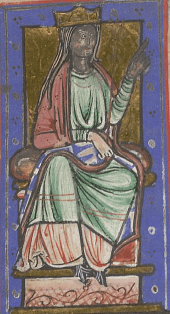Ealhswith facts for kids
Quick facts for kids Ealhswith |
|
|---|---|
 |
|
| Died | 5 December 902 |
| Burial | New Minster, Winchester |
| Spouse | |
| Issue | |
| Father | Æthelred Mucel |
| Mother | Eadburh |
Ealhswith (died December 5, 902) was the wife of King Alfred the Great, a famous king of England. Her father, Æthelred Mucel, was a nobleman from Mercia, an important kingdom at the time. Her mother, Eadburh, was also part of the Mercian royal family. Ealhswith is remembered as a saint in some Christian traditions.
Contents
Early Life and Marriage
Ealhswith was born into a powerful family in Mercia. Her father was a leader of a group called the Gaini. Her mother was related to the royal family of Mercia. This meant Ealhswith had an important background.
She married Alfred in 868 in Gainsborough, Lincolnshire. At that time, Alfred's older brother, Æthelred, was the king. Alfred was expected to become king next. Their marriage was likely a way to create a strong alliance between the kingdoms of Wessex and Mercia. This alliance was important because the Danes, who were Vikings, had taken over the Mercian town of Nottingham that same year. Alfred became king in 871 after his brother died.
Life as a Royal Wife
Ealhswith is not mentioned much in the old writings from her time. She did not sign any official documents during her husband's rule. A writer named Asser wrote about Alfred's life. He mentioned Ealhswith's parents and their wedding date. However, he only called her "a noble Mercian Lady" and did not use her name.
In Wessex during the 800s, the king's wife was not usually called "queen." King Alfred explained that this was because of a past queen named Eadburh. She had accidentally poisoned her husband while trying to poison someone else. This event made people wary of giving the title of queen.
After King Alfred died in 899, Ealhswith became more visible. In 901, she signed an official document during her son Edward's rule. She was called "Ealhswið mater regis," which means "Ealhswith, mother of the king." Her name was written right after King Edward's name. It was also placed before the name of Edward's own wife, Ælfflæd. This shows her important position as the king's mother.
Royal Estates and Legacy
In his will, King Alfred left Ealhswith three important estates. These places had special meaning. One was Edington in Wiltshire. This was where Alfred won a big battle against the Vikings. Another was Lambourn in Berkshire, near another victory site. The third was Wantage, which was Alfred's birthplace. These lands were part of the royal family's special property. They stayed with the royal family even after Ealhswith passed away.
After Alfred's death in 899, Ealhswith started a new religious community. She founded a convent for nuns called St Mary's Abbey, Winchester, also known as the Nunnaminster. She died on December 5, 902. Ealhswith was buried in the New Minster, Winchester. This was a new abbey built by her son, King Edward. She is remembered in old writings as "the true and dear lady of the English."
Ealhswith's brother, Æthelwulf, was also an important person. He was a leader in western Mercia in the 890s. He worked under his niece's husband, Æthelred, Lord of the Mercians. Æthelwulf died in 901.
Children of Ealhswith and Alfred
Ealhswith and King Alfred had five children who grew up to be adults:
- Æthelflæd (died 918), who became the Lady of the Mercians. She married Æthelred, Lord of the Mercians.
- Edward the Elder (died 924), who became the King of the Anglo-Saxons after his father.
- Æthelgifu, who became the abbess (leader) of a religious house in Shaftesbury. Her father, King Alfred, helped her become abbess.
- Ælfthryth, Countess of Flanders (died 929), who married Baldwin II, Count of Flanders.
- Æthelweard (died around 920).
See also

